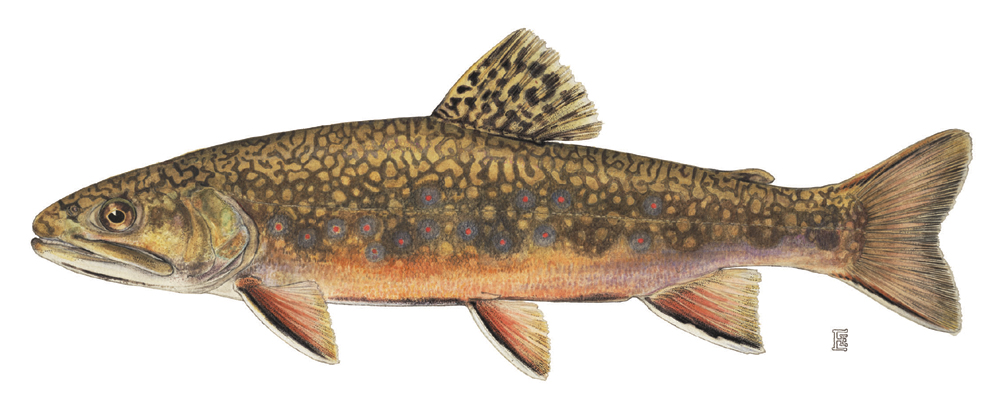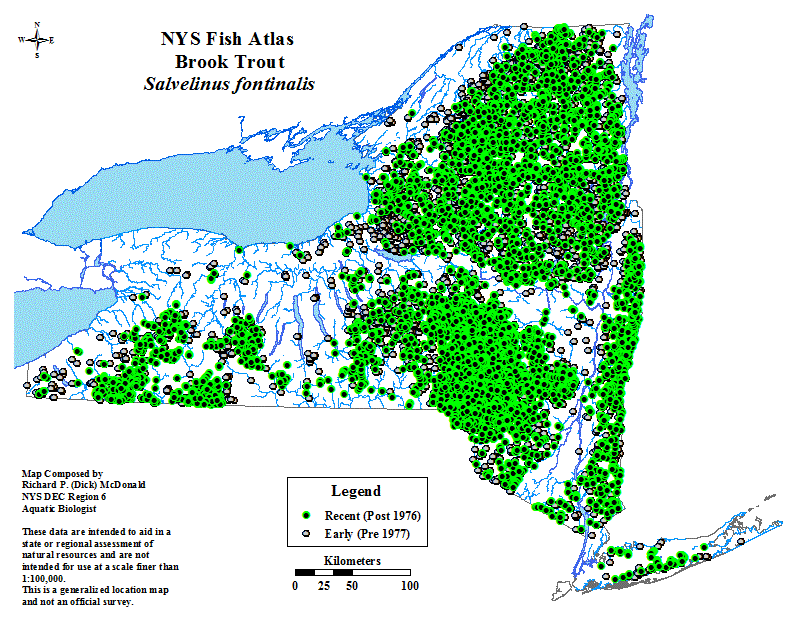
Brook Trout (Salvelinus fontinalis)
Brook trout, along with lake trout, belong to the "char" sub-group of salmonine fishes that is distinct from the "true" trout and salmon. Originally found only in eastern North America, brook trout were historically so common in New York lakes and ponds that early surveys noted waters in which brook trout were absent, and did not bother noting their presence. Brook trout, also called "speckled trout," are officially designated the state fish of New York.
In spite of their name, brook trout are often found in lakes and are also common in cold, clear headwater streams. Like most salmonid fishes, brook trout thrive in waters with low temperatures and high oxygen content. Some coastal river populations also inhabit salt water, though populations of such "salters" are no longer found in New York and are largely restricted to Canada's maritime provinces. "Coaster" brook trout populations were reported by early settlers in the upper Great Lakes (Superior, Huron and Michigan), though it is unclear whether such populations once existed in Lake Ontario. Brook trout populations are usually dominated by small fish (less than 12 inches in length), and never reach sizes greater than five pounds in New York waters. Their relatively short lifespan (typically five years maximum) and slow growth rates contribute to their generally small size.
Brook trout spawn in the fall within sand and gravel areas where upwelling groundwater occurs. Lake-dwelling fish spawn in tributary streams or along the shoreline. Spawning takes place from late September to November during daytime, by contrast with night-time spawning lake trout. As spawning season approaches the colors of brook trout are greatly intensified, especially in males whose flanks and belly become orange-red with a black stripe along each side. Aggregations of spawning brook trout can often be observed in small tributaries and along lake shorelines, with solitary females seen digging and remaining within the perimeter of shallow nests, and numerous males looking for an opportunity to dart into these nests to fertilize eggs deposited by the resident female. Brook trout "redds" or nests are often found in large aggregations.
Surviving brook trout eggs hatch from February to April, still buried within their gravel spawning beds. Young brook trout grow faster than lake trout because small brook trout are able to live in warmer nearshore and tributary areas that produce abundant insect larvae and other small crustaceans. Larger brook trout are able to feed upon small fish and crayfish, though these fish are also restricted to cold, deepwater habitats during warm mid-summer conditions. Although brook trout are relatively acid-tolerant and can withstand pH conditions as low as 5.0, many brook trout populations in the southwestern Adirondacks and Catskills have been eliminated or greatly reduced due to decades of acid rain deposition. Brook trout have also been eliminated from suitable coldwater habitats within lakes and streams due to predation and competition with non-native smallmouth bass and brown trout.
Distribution of brook trout in NY state.
An image of the brook trout is also available for download.
